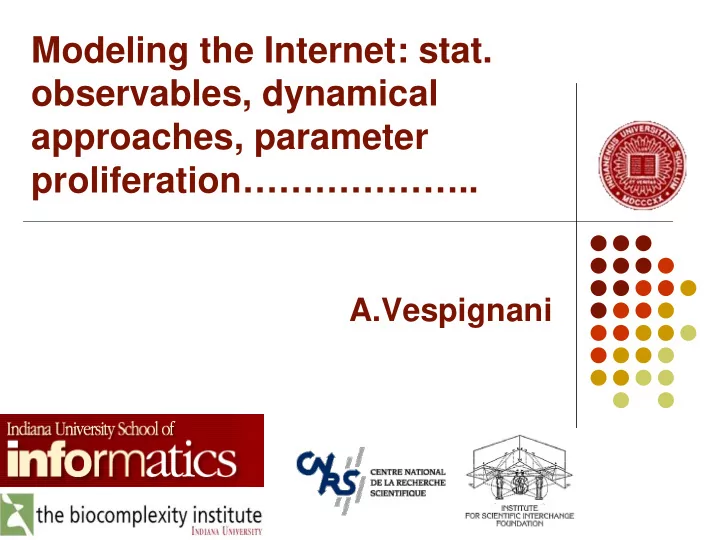

Modeling the Internet: stat. observables, dynamical approaches, parameter proliferation……………….. A.Vespignani
Collaborators � Romualdo Pastor-Satorras � Ignacio Alvarez-Hamelin � Luca Dall’Asta � Alain Barrat � Vic Colizza � Mark Meiss � Filippo Menczer � Mariangels Serrano � Alexei Vazquez
Once upon a time there was the physical Internet….
The beginning….. Faloutsos et al. 1999 Measurement infrastructures Degree distribution of the Internet graph Passive/active measurements (AS and Router level) (CAIDA; NLANR; Lumeta…)
Internet graphs….. � Skewed � Heterogeneity and high variability � Very large fluctuations (variance>>average) � Various fits : power- law+cut-off; Weibull etc.
� Higher order statistical characterization…. � Model validation…… � Model construction…..
Multi-point correlations P(k,k’) • 0-dimensional projection (pearson coefficient) M. Newman (2002) • One-dimensional projection (average nearest neighbor degree) Pastor-Satorras & A.V. (2001) • Three dimensional analysis Maslov&Sneppen (2002)
Multi-point correlations P(k,k’) Average nearest neighbors degree k nn (i) = Σ j k j 1 k i Correlation spectrum: Average over degree classes < k nn ( k )>
< k nn ( k )> = Σ k’ k’ p( k’|k ) Degree correlation function Assortative behaviour: growing k nn (k) � Example: social networks Large sites are connected with large sites k (k) nn Disassortative behaviour: decreasing k nn (k) � Assortative Example: internet Large sites connected with small sites Disassortative k k
Degree correlation < k nn ( k )> = Σ k’ k’ p( k’|k ) function Highly degree ASs connect to low degree ASs Low degree ASs connect to high degree ASs No hierarchy for the router map Pastor Satorras, Vazquez &Vespignani, PRL 87, 258701 (2001)
Clustering coefficient = connected peers will likely know each other n 3 Higher probability to be connected 2 1 # of links between 1,2,…k neighbors C = k(k-1)/2
Clustering spectrum Clustering spectrum This is a kind of three-points correlation function…..
Clustering Spectrum Spectrum in the Internet in the Internet Clustering Clustering coefficient as a function of the vertex degree Highly degree ASs bridge not connected regions of the Internet Low degree ASs have links with highly interconnected regions of the Internet Vazquez et al. Physical Review E 65, 066130 (2002).
Rich-Club coefficient Fraction of edges shared by nodes of degree > k with respect to the Maximum allowed number. Increasing interconnectivity for increasing k Rich-club phenomenon??
Normalized rich-club coefficient It is possible to show that for a completely uncorrelated network Coefficient of the maximally randomized equivalent graph NO rich club phenomenon V.Colizza et al.
K-shell K-shell K-shell K-core decomposition
K-core structure…
http://xavier.informatics.indiana.edu/lanet-vi
Non-local measure of centrality Betweenness centrality = # of shortest paths traversing a vertex or edge (flow of information ) if each individuals send a message to all other individuals
Beteweenness Probability distribution Heavy-tailed and highly heterogeneous
Classical topology generators • Waxman generator Exponentially Bounded Degree distributions • Structural generators Transit-stub Tiers Scale-free topology generators INET (Jin, Chen, Jamin) BRITE (Medina & Matta) Modeling of the Network structure with ad-hoc algorithms tailored on the properties we consider more relevant
What about the degree distribution ? Heavy tails ? Static construction Molloy-reed Position model Hidden variables Etc. Generalized random graphs with pre-assigned degree distribution
Shift of focus: Static construction Dynamical evolution Direct problem Evolution rules Emerging topology Inverse problem Given topology Evolution rules
P(k) ~k -3 (Barabasi& Albert 1999) The rich-get-richer mechanism
Continuous approximations Average degree value that the node born at time s has a time t { } Evolution equation Degree distribution
� BA is a conceptual model…. � It has not been thought to specifically model the Internet � More details/realism/ingredients needed
Degree distribution Preferential attachment component Dynamical evolution COPY MODEL
More models • Generalized BA model Non-linear preferential attachment : Π (k) ~ k α (Redner et al. 2000) Initial attractiveness : Π (k) ~ A+k α (Mendes & Dorogovstev 2000) Rewiring (Albert et al.2000) • Highly clustered (Eguiluz & Klemm 2002) η k Π ≅ i i ( k ) • Fitness Model ∑ η i k j j j (Bianconi et al. 2001) • Multiplicative noise (Huberman & Adamic 1999)
Heuristically Optimized Trade-offs (HOT) Papadimitriou et al. (2002) New vertex i connects to vertex j by minimizing the function Y (i,j) = α d (i,j) + V (j) d= euclidean distance V( j )= measure of centrality Optimization of conflicting objectives
Model validation…… � Correlations � Clustering � Hierarchies (k-cores, modularity etc.) � ………..
Clustering spectrum Correlation spectrum
Clustering spectrum Correlation spectrum
Rich-club coefficient
K-core structure
http://xavier.informatics.indiana.edu/lanet-vi
-R model R model E- E
B-A Model
Wide spectrum of complications and complex features to include… IP 2 IP 1 IP 3 Simple Realistic Ability to explain (caveats) Model realism looses in trends at a population level transparency. Validation is harder.
Wide spectrum of complications and complex features to include… IP 2 IP 1 IP 3 Data driven Conceptual/theoretical Value if data are realistic and parameters are physical
Agent Based Modeling � The good… � Data driven: Demographic, societal, census data from real experiments � Sensibility analysis / scenario evaluation � The bad… � Non-physical parameters � (non-measurable/fitness/unmotivated parameters etc.)…
Physical Parameters ?? � Measurable quantity. � Combination of measurable quantities. � Parameters appearing from the symmetry and consistency of equations. Hints.. � Minimum number of free (measurable) parameters…. � Falsifiable requisite for the model….
A few examples…. � BA model � Rewiring/copy model η k Π ≅ � Fitness model i i ( k ) ∑ η i k j j j � HOT Y(i,j) = a d(i,j) + V(j)
� Census/societal data � Geographical data � Traffic data � In the lack of that ……..topology generators!! (Using measurement data)
Effect of complex network topologies on physical processes � Epidemic models � Resilience & robustness � Avalanche and failure cascades � Search and diffusion…..
Recommend
More recommend